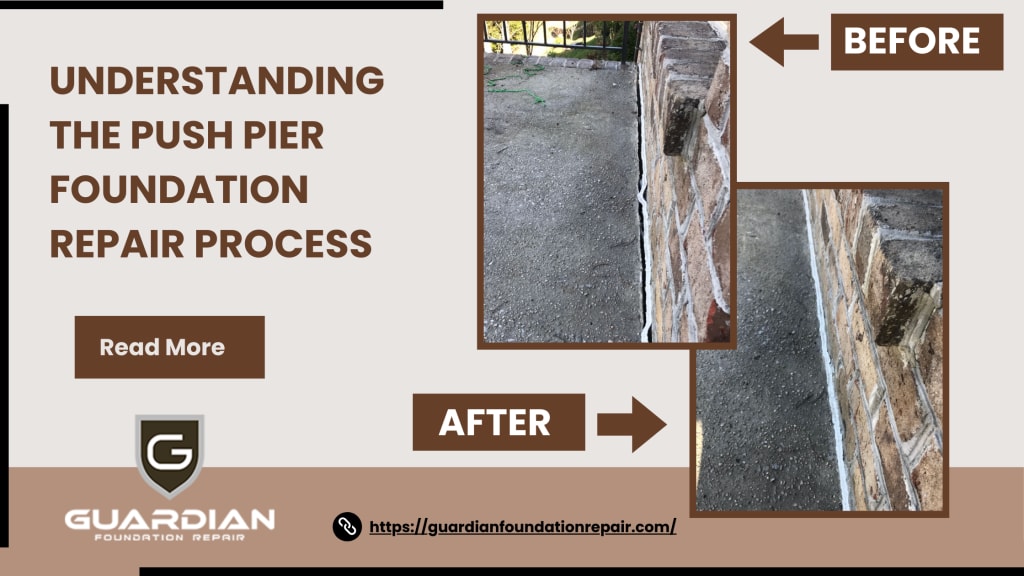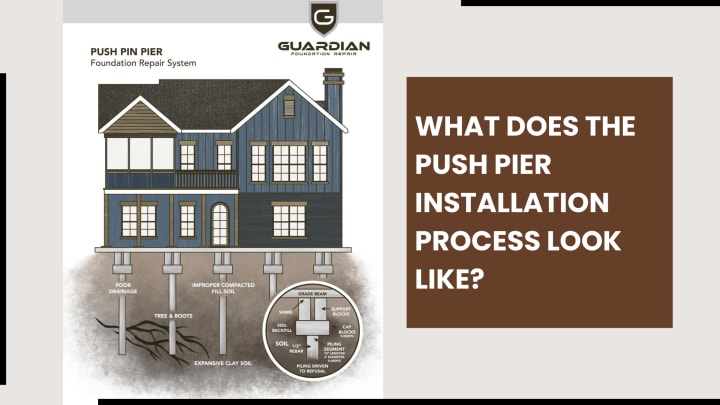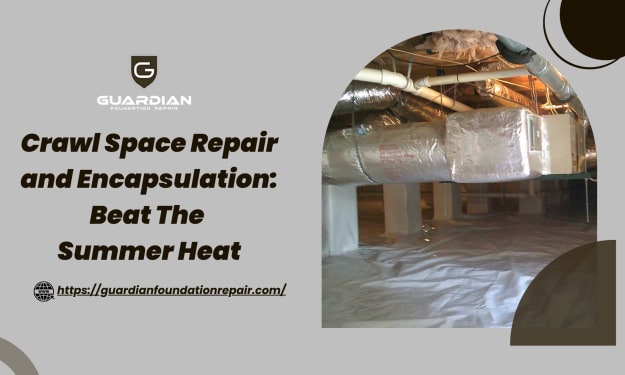Understanding the Push Pier Foundation Repair Process
Find the expert push pier foundation repair process. Learn how foundation push piers stabilize and lift structures to address soil issues for stability.

The foundation of your home is important for its stability and value. It's no surprise that one in four homes experiences foundation issues, which can lead to a drop in value if left unresolved. Fortunately, there is an effective solution known as push pier foundation repair.
The primary cause of foundation problems is often the moisture level in the ground, resulting in soil expansion, sinking, erosion, or shifting. These issues can lead to cracks, movement, or even structural failure.
Repairing the foundation deep beneath the ground can be hard. That's where push piers come in. If you're seeking information about push pier foundation repair, you're on the right page. This blog post will explain what push piers are, their installation process, and more.
By the end, you will clearly understand how push piers work and how they can secure your foundation against further settlement.
What are Push Piers?
So, exactly what is a push pier? Push piers are galvanized-contractor-grade-steel pipes that are hydraulically driven into competent, load-bearing soil and securely anchored to a foundation's prepped footing to secure, stabilize, and lift a structure.
These structural steel piers are pushed deep into the ground to stabilize the house foundation. They address issues such as settling soil changes, broken footings, slanted or uneven foundations, and cracks in the structure. Unlike replacing an entire foundation, using push piers is a more affordable and less invasive option.
The installation process involves:
- Exposing part of the foundation.
- Securing a bracket to the footing.
- Pushing the pier deep into the earth through a drive stand until it reaches a solid, stable surface.
Push piers are among the most common repair methods for foundations experiencing differential settlement. They provide stability without requiring large equipment or extensive renovations. Underpinning using push piers is a minimally invasive process, offering a cost-effective and efficient solution to stabilize your foundation.
Does My Home Need Foundation Push Piers?
Suppose a question comes to your mind: Does my Knoxville home need push piers? It is a common question homeowners ask when faced with foundation issues. To decide if foundation push piers are the best solution, the first step is to identify the type of structural damage in your foundation.
Signs such as sinking foundations, sagging walls, or small cracks indicate a need for stabilization. If the damage is not severe, push piers can be an effective solution.
However, it is important to seek advice from professionals offering services for push pier foundation repair Knoxville. While push piers provide excellent support, they may not be suitable for every home. Consult a reliable foundation expert who can assess your needs and suggest an ideal solution for strengthening your home's foundation.
How are Push Piers Different from Other Foundation Repair Options?
Push piers are just one of many options available for foundation repairs. An alternative method involves injecting polyurethane foam beneath the foundation to lift sinking foundations. However, this approach is limited to minor lifts and cannot address major foundation issues.
Another option often confused with push piers is helical piles. These long steel beams support the foundation, much like push piers. The main difference lies in their design. Helical piles resemble giant screws with helical plates that are drilled into the ground at an angle. If necessary, they can also be installed before the foundation is laid, particularly in unstable ground conditions.
In contrast, push piers use hydraulic pressure to drive the piers into the ground. They have a higher weight-bearing capacity than helical piles, making them suitable for larger structures such as multi-level homes.
In some cases, push piers and helical piers can be combined to improve overall structural stability. Knowing these differences will help you make the right decision when choosing the most appropriate house foundation repair option for your specific needs.
What Does The Push Pier Installation Process Look Like?

Picture underground stilts supporting your home above unstable soil that causes foundation issues. Push pier systems are designed to reach the depth by adding pipe sections with slip-in couplings, allowing them to be securely connected until they reach bedrock.
These galvanized steel pipes are built to resist rust and water damage, ensuring durability even in wet conditions. With an impressive load capacity of up to 68 thousand pounds, push piers offer strength and stability. They come in different sizes, ranging from 2-7/8", 3.5", to 4.5", providing flexibility to cater to push pier foundation repair needs.
Typically driven to 25-30 feet depths, push piers can go as shallow as 10 feet or as deep as an astonishing 150 feet. The push pin pier systems act as a reliable underground stilt system, offering rust-proof support that can be driven into stable, load-bearing soil, providing long-lasting foundational support for years.
Excavating and Fitting the Remedial Bracket for Push Pier Installation
To begin the push pier installation process, accessing the affected area is crucial. Clearing away debris like sidewalks, cement patios, or flowerbeds ensures easy access. The concrete will be replaced once the project is complete, and any disturbed landscaping will be restored.
Excavation marks the first step: digging a 3x3 foot hole (typically 18-24 inches deep) to reach the foundation footing. Following the repair plan, these excavation sites are demarcated with stickers or painter's tape every 6 feet.
Once the footing is exposed, the concrete is carefully flattened to create a surface for the remedial bracket. This bracket, shaped like an "L," is designed to fit securely onto the footing, allowing the drive stand to attach later and guide the push piers to competent, load-bearing soil.
The remedial bracket is fastened to the footing using "redhead" bolts with expanding ends that lock into the cement. A washer and nut securely attach the remedial bracket to these bolts, and additional screws can be used for added stability, connecting the bracket to the home's footing.
Push Pier Installation for Stability
After installing the remedial bracket, the drive stand is attached to initiate the push pier installation. This component serves a dual purpose: guiding the push piers and housing the hydraulic ram system.
Typically, a single crew member handles this step while others continue with excavation or attach remedial bracket hardware. The crew member will estimate the amount of required steel pipe within reach and begin driving the pier into the ground by loading it into the drive stand and using the hydraulic ram.
The same process is repeated until the push piers reach the necessary depth, ensuring stability by reaching competent, load-bearing soil.
Push Pier Load Transfer for Lift or Stabilization
Once they install push piers for foundation repair, your home can be lifted back to its maximum practical recovery or stabilized. If you prefer stabilization, the remedial brackets are capped to prevent further settlement.
Lifting your home does not compromise its structural integrity. For maximum practical recovery, hydraulic lift cylinders are used at each push pier location. These cylinders, controlled by valves, lift the home in unison while monitoring with Ziplevel floor measurements to ensure a controlled, level lift. As different areas of the home return to level, corresponding cylinders are turned off, allowing others to continue lifting.
The lift, measurement, and valve adjustments continue until the home reaches a level position. Once the lift is complete, the push pier hardware is tightened, and the cylinders are removed from the piers. The entire lifting process typically takes 2-3 hours.
During the lift, expect phenomena such as cracked drywall closing together, sloped floors evening out, slanted windows and doorframes returning to square, and doors becoming easier to open and close.
Void Fill or Adjustments for Push Pier Repair
At the time of the push pier foundation repair lift, voids may form underneath your foundation. Depending on the type of foundation (slab or raised), specific measures are taken to support the interior floor and fill the gaps left by the lifted foundation.
Polyurethane is injected between the bottom of the home slab and the soil for the slab on grade foundations. This fills the gaps and re-supports the structure.
Raised foundations require adjustments to posts and pads to ensure contact with the girder beams supporting the subfloor. Damaged posts and pads are replaced to ensure proper floor support.
Push Pier Final Walkthrough for Assessment
Following the push pier lift and stabilization, a final walkthrough is conducted. It involves visually inspecting previously affected areas with specific attention to stucco cracks, drywall cracks, sloped floors, and chimneys (which often have their own mini foundation). In addition to visual cues, the floor elevation measurements are retaken and compared to the initial foundation inspection.
Push Pier Excavation Backfill for Completion
After the final house foundation repair walkthrough, the excavation holes are backfilled, concrete is repoured, and shrubs are replanted. This step is the simplest part of the push pier foundation repair process.
Let Experts Help You With Push Pier Foundation Repair!
In this post, you have gained a clear understanding of push pin pier systems and their installation process, from excavations to lifts. With this knowledge, you can confidently choose foundation push piers as a reliable solution for your repair needs.
Simply find a house foundation repair professional experienced in push pier installation. If you suspect foundation issues in your home, you must reach out to these experts and schedule a foundation inspection. If a problem is found, they will provide a free estimate for push pier foundation repair solutions or other suitable options.
Now, relax and enjoy the stability and increased value that push piers bring to your home's foundation.
About the Creator
Guardian Foundation Repair
Best foundation repair service provider in Knoxville, TN - Guardian Foundation Repair. We provide services like foundation repair, basement repair, crawl space, and water management. For more details contact us at our website.
Enjoyed the story? Support the Creator.
Subscribe for free to receive all their stories in your feed. You could also pledge your support or give them a one-off tip, letting them know you appreciate their work.






Comments
There are no comments for this story
Be the first to respond and start the conversation.